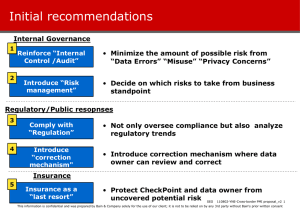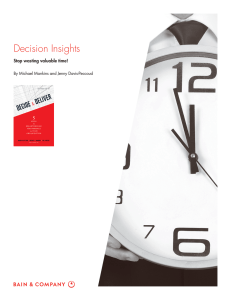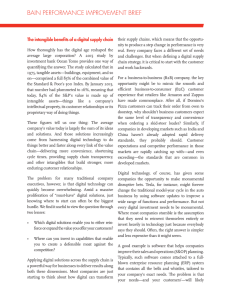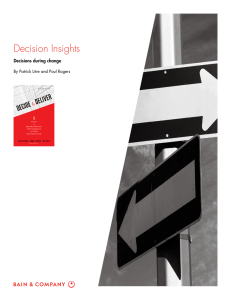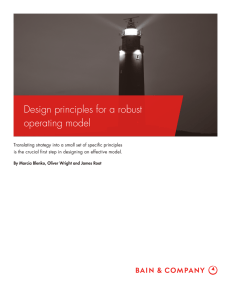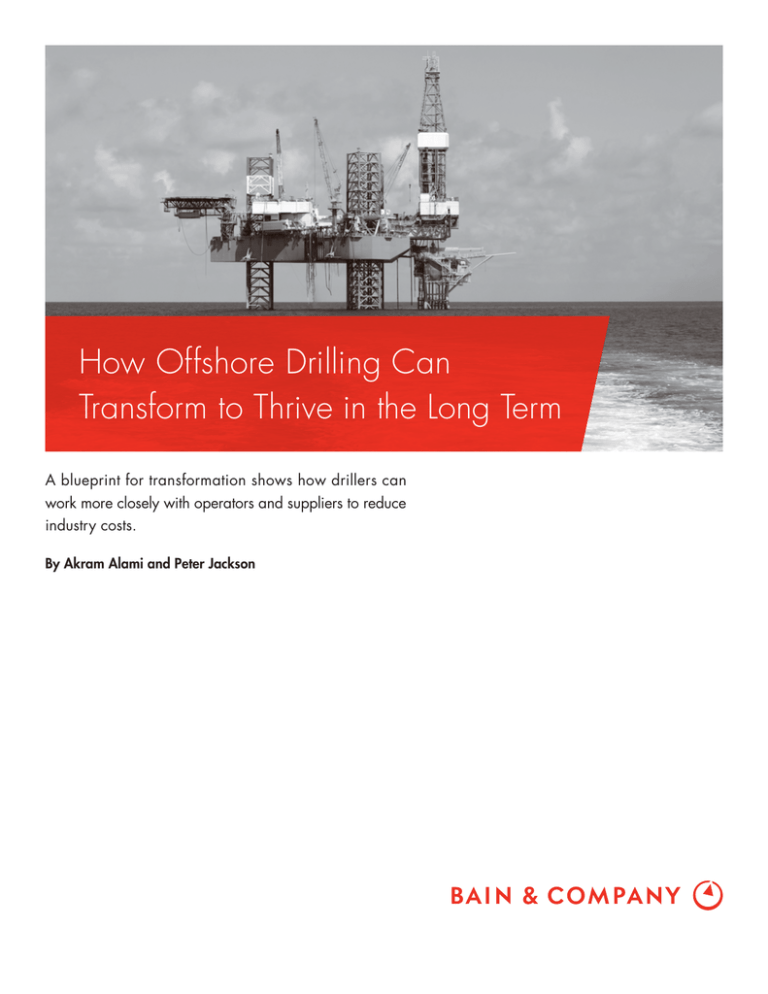
How Offshore Drilling Can
Transform to Thrive in the Long Term
A blueprint for transformation shows how drillers can
work more closely with operators and suppliers to reduce
industry costs.
By Akram Alami and Peter Jackson
How Offshore Drilling Can Transform to Thrive in the Long Term
Even before oil prices began to drop in the summer of
2014, day rates for drilling rigs had begun to sag due to
overcapacity in the market. Since then, as the price of
oil has dropped by 70%, offshore operators have put
tremendous pressure on their suppliers, asking them
to help reduce the total costs of offshore production and
keep their barrels competitive. Drillers saw their rates cut
in half, and customers began asking for the lowest-cost
rigs available, questioning the value of the more technologically advanced rigs and pushing drilling contractors
to offer sixth-generation rigs at fifth-generation rates.
This decline in activity hit the drilling industry hard, with
the top five contractors losing $35 billion in market capitalization between the third quarter of 2014 and the third
quarter of 2015, and credit rating agencies lowering
the debt rating for offshore drillers across the board.
These developments pose an existential threat for offshore drillers, who need access to capital to build rigs,
along with some degree of certainty about activity in
order to develop their scenario-based plans for building
and stacking decisions on the fleet.
To survive in the short term, drillers have had to shift
away from their focus on pushing technical boundaries
at the frontiers to creating efficiencies that will allow
them to operate more effectively. Since many in the
industry have adjusted their outlook based on the
probability of oil remaining below $50 per barrel out
to 2020, most drillers will need to work closely with
their customers and suppliers to bring transformative
change to the industry and allow them to continue to
operate. (For more on Bain’s Integrated Energy Outlook, read “What the Recent Oil Price Shock Teaches
about Managing Uncertainty.”)
Cost reductions and innovation
By now, everyone in the oil and gas industry has already
made the easy reductions—and plenty of painful ones,
too. Capex fell more than 20% from 2014 to 2015. Cuts
this deep were not easy to make, yet the industry will
likely see similar or greater reductions in 2016, with some
operators reporting cuts of more than 40%. Most of
the top five drillers have announced layoffs in recent
Copyright © 2016 Bain & Company, Inc. All rights reserved.
months, shut down satellite offices and started optimizing their overall cost structure. At the same time,
companies also will have to start making more structural changes to survive the low-price environment.
Drilling contractors have a critical role to play in the viability
of the offshore industry. Well costs typically comprise about
40% of an offshore project, and the technical and regulatory challenges associated with drilling in deep water played a
significant role in fueling offshore inflation in the run-up to
2014, just as the onshore US industry was dramatically increasing drilling productivity.
A transformation plan should help executives focus on the key parameters of
success in the sector, including costs,
customers and specifications.
The offshore industry has historically operated in silos,
but to make the necessary changes in cost and productivity, drillers will need to work much more closely
with operators and their own suppliers. Some of these
changes will come in the form of innovation to reduce
customers’ costs. For example, operators and suppliers
could collaborate to streamline procurement processes
and integrate technical and operational developments.
Productivity matters more than ever, as offshore producers compete with shale suppliers to produce the
marginal barrel. Whereas shale operators can quickly
taper off their most expensive operations, offshore projects are long-term, multibillion dollar bets, which are
more difficult to shut on and off, and so require a more
concentrated cost-saving effort.
A blueprint for transformation
A transformation plan should help executives focus on
the key parameters of success in the sector, including
costs, customers and specifications (see Figure 1).
The relative importance of the elements will differ for
How Offshore Drilling Can Transform to Thrive in the Long Term
Figure 1: A blueprint for transformation in offshore drilling
Winning
asset strategy
Customer
focus
Operational
excellence
High-performance
organization
• Consolidate the fleet
footprint around the
medium-term needs
of the industry
• Build tighter links
to customer asset
strategy and
operating philosophy
• Achieve the safest,
most stable and
efficient operating
model for all rigs
• Achieve the safest,
most stable and
efficient operating
model for all rigs
• Manage global
capacity through
decommissioning
and roll-up M&A
• Proactively use
customer data to
recommend cost
opportunities
• Implement a best-inclass, comprehensive
operational excellence
management system
• Implement a best-inclass, comprehensive
operational excellence
management system
• Reduce customer
costs via longerterm agreements
• Slash SG&A and
stacking costs
• Slash SG&A and
stacking costs
Maximum
enterprise value
• Rethink the capital
efficiency model to
share the risk of debt
• Seek new finance
sources
Technology and digital transformation
• Design to cost and operational specifications
• Increase automation and condition-based maintenance
Source: Bain & Company
their financial stakes in drilling companies to secure, align with and influence a key part of their
supply chain.
each driller, but in all cases the transformation will be
stronger when drilling contractors work closely with
their customers and suppliers.
•
Winning asset strategy. Many companies will have
to reassess their portfolios, making sure they can
play in the market segments most likely to see activity. Most will need to redefine their fleets to match
those opportunities—and likely will have to speed
up retirement of some older rigs. Operators and
drillers should collaborate in developing scenarios
for balancing the supply and demand of rigs over
the long term to reduce the risk of fleet investments.
•
Operational excellence. Incompatibility of standards
can account for a significant portion of costs in
drilling. Operators and contractors should align on
safe, effective, efficient and compatible standards
to create a step change in performance.
•
Maximize enterprise value. Drilling contractors
should be exploring options for operators to raise
•
Technology. Operators, drilling contractors and equipment providers are working together to transform
the end-to-end technology solution with smaller rigs
and blowout preventers, more automated drilling
and condition-based maintenance.
Some elements will take longer than others, such as
designing new technology, revising the operating model
and implementing an M&A plan that delivers real value.
But no one can say when prices will recover, and since
rig rates tend to lag market recoveries by about 18 months,
a transformation is a necessary, no-regrets move that
will position drillers for the next wave in the sector’s
cyclical nature.
Akram Alami is a partner with Bain & Company in
Dubai, and Peter Jackson is a partner in Bain’s London
office. Both work with Bain’s Global Oil & Gas practice.
Shared Ambit ion, True Results
Bain & Company is the management consulting firm that the world’s business leaders come to when they
want results.
Bain advises clients on strategy, operations, technology, organization, private equity and mergers and acquisitions. We develop practical,
customized insights that clients act on and transfer skills that make change stick. Founded in 1973, Bain has 53 offices in 34 countries,
and our deep expertise and client roster cross every industry and economic sector. Our clients have outperformed the stock market 4 to 1.
What sets us apart
We believe a consulting firm should be more than an adviser. So we put ourselves in our clients’ shoes, selling outcomes, not
projects. We align our incentives with our clients’ by linking our fees to their results and collaborate to unlock the full potential of their
business. Our Results Delivery® process builds our clients’ capabilities, and our True North values mean we do the right thing for
our clients, people and communities—always.
Key contacts in Bain’s Global Oil & Gas practice
Americas
Europe, Middle East and Africa
Akram Alami in Dubai (akram.alami@bain.com)
Lars Jacob Bø in Oslo (larsjacob.boe@bain.com)
Joachim Breidenthal in Johannesburg
(joachim.breidenthal@bain.com)
Luca Caruso in Moscow (luca.caruso@bain.com)
Juan Carlos Gay in London (juancarlos.gay@bain.com)
Lili Chahbazi in London (lili.chahbazi@bain.com)
Christophe de Mahieu in Dubai (christophe.demahieu@bain.com)
Peter Jackson in London (peter.jackson@bain.com)
Torsten Lichtenau in London (torsten.lichtenau@bain.com)
Olya Linde in Moscow (olya.linde@bain.com)
Asia-Pacific
Alain Masuy in Dubai (alain.masuy@bain.com)
Roberto Nava in Milan (roberto.nava@bain.com)
Sharad Apte in Bangkok (sharad.apte@bain.com)
Francesco Cigala in Kuala Lumpur (francesco.cigala@bain.com) Peter Parry in London (peter.parry@bain.com)
Lodewijk de Graauw in Perth (lodewijk.degraauw@bain.com) Tiziano Rivolta in Milan (tiziano.rivolta@bain.com)
Karim Shariff in Dubai (karim.shariff@bain.com)
Dale Hardcastle in Singapore (dale.hardcastle@bain.com)
Natan Shklyar in Moscow (natan.shklyar@bain.com)
Brian Murphy in Perth (brian.murphy@bain.com)
John Smith in London (john.smith@bain.com)
Luis Uriza in London (luis.uriza@bain.com)
Riccardo Bertocco in Dallas (riccardo.bertocco@bain.com)
Pedro Caruso in Houston (pedro.caruso@bain.com)
Ricardo Gold in São Paulo (ricardo.gold@bain.com)
Eduardo Hutt in Mexico City (eduardo.hutt@bain.com)
Jorge Leis in Houston (jorge.leis@bain.com)
Rodrigo Mas in São Paulo (rodrigo.mas@bain.com)
John McCreery in Houston (john.mccreery@bain.com)
John Norton in Houston (john.norton@bain.com)
Ethan Phillips in Houston (ethan.phillips@bain.com)
José de Sá in São Paulo (jose.sa@bain.com)
For more information, visit www.bain.com

